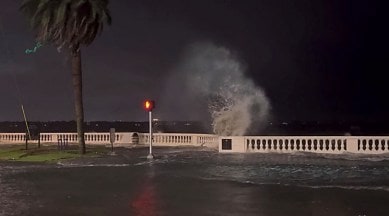Stay updated with the latest - Click here to follow us on Instagram
Hurricane Idalia: All you need to know about the storm as it makes landfall in Florida
After Florida, the hurricane is further expected to move along the coasts of Georgia, South Carolina, and North Carolina late today and Thursday.

Hurricane Idalia made landfall on Florida’s west coast as a dangerous Category 3 storm on Wednesday morning. Being called “an unprecedented event” by the National Weather Service in Tallahassee, the hurricane is further expected to move along the coasts of Georgia, South Carolina, and North Carolina late today and Thursday.
Here are 10 things to know about Hurricane Idalia
monthly limit of free stories.
with an Express account.
- 01
When did Hurricane Idalia make the landfall?
Hurricane Idalia made landfall on Florida's west coast as a dangerous Category 3 storm on Wednesday unleashing storm surges and rainfall in the area. The hurricane which gained steam in the warm waters of the Gulf of Mexico, triggered mass evacuations in the low-lying areas of Florida ahead of its landfall early Wednesday morning.
- 02
Where did the hurricane make the landfall?
It made landfall near Keaton Beach at 7:45 am with maximum sustained winds near 125 mph (205 kph). Forecasters said it would remain a hurricane while crossing Florida and Georgia before punishing the Carolinas as a tropical storm.
- 03
Which areas were impacted by the hurricane before Florida?
Earlier on Monday and Tuesday, it had damaged homes and flooded villages in the west of Cuba. The heavy rains left the tobacco-growing province of Pinar del Rio underwater and many of its residents without power.
- 04
What was the speed of the hurricane Idalia as it hit Florida?
Feeding on the warm, open waters of the Gulf of Mexico it was briefly a Category 4 event (maximum sustained winds of at least 130 mph), but dropped back to Category 3 strength just before sunrise. Any storm designated Category 3 or higher is classified as a major hurricane.
- 05
Which areas in Florida stand affected?
Idalia’s centre hit Florida’s coastline in the Big Bend region, where the state's northern panhandle curves into the Gulf side of the Florida Peninsula. It includes the inland city of Tallahassee – the state capital, Gainesville and Pensacola. Florida is already dealing with the damages caused by Hurricane Ian which peaked at Category 5 in September 2022.
- 06
How high can the storm surge rise?
Idalia is being called “an unprecedented event” by the National Weather Service in Tallahassee, as it says that no major hurricanes on record have ever passed through the bay abutting the Big Bend. The storm surge could rise as high as 15 feet (4.5 meters) in some places across northern Florida.
- 07
What did Florida Governor Ron DeSantis say?
Florida Governor Ron DeSantis urged the residents in living in the low-lying and vulnerable areas to “get to higher ground in a safe structure.” “You can ride the storm out there, then go back to your home,” he said. State emergency declarations have been issued in Florida, Georgia and South Carolina.
- 08
What did US President Joe Biden say?
Meanwhile, US President Joe Biden said that he was in constant contact with DeSantis and had assured the governor that federal disaster assistance would remain in place for as "long as it takes, and we’ll make sure they have everything they need.”
- 09
What are the safety measures taken?
More than 40 school districts in Florida have cancelled classes, Florida Governor DeSantis informed. Tampa International Airport has been closed to commercial operations and has plans to reopen on Thursday.
According to DeSantis, about 5,500 National Guard members were mobilised, while 30,000 to 40,000 electricity workers were placed on standby. “The state has set aside 1.1 million gallons of gasoline to address any interruptions to fuel supplies,” he said.